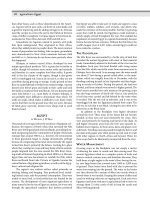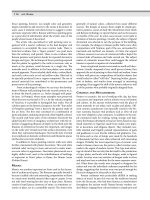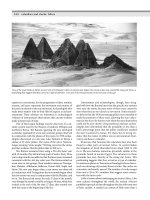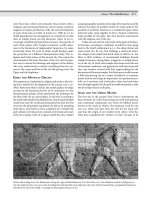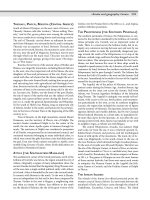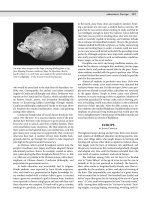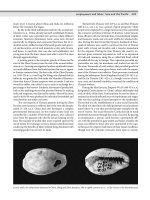Encyclopedia of society and culture in the ancient world ( PDFDrive ) 765
Bạn đang xem bản rút gọn của tài liệu. Xem và tải ngay bản đầy đủ của tài liệu tại đây (54.32 KB, 1 trang )
692
migration and population movements: Africa
but the kingdom also engaged in a great deal of trade with
Rome and other Mediterranean powers.
SUB-SAHARAN AFRICA
BANTU EXPANSION
EAST AFRICA
Between 40,000 and 8000 b.c.e., southern Africa was occupied
by people known as Sangoan. By the beginning of the ancient
period these people had developed into the culture known as
Khoisan, or Bushmen. They spoke a distinctive language that
included many clicking sounds. Archaeologists believe that
the Khoisan were one of the oldest distinct groups of humans.
Studies of modern Khoisan genes show that the Khoisan
people were isolated from other genetic groups up to 100,000
years ago. The Khoisan people had a distinctive appearance,
with copper-colored skin, high cheekbones, long legs, and
an overall short stature. Their eyes had distinctive folds of
skin, similar to those of Asian peoples. Khoisan women had
a tendency to accumulate fat in their buttocks, possibly an
adaptation to life in a harsh climate with an unpredictable
food supply. The Khoisan lived throughout the southern half
of the continent, in modern-day Angola, Namibia, Botswana,
and South Africa. They were adapted to life in dry desert conditions and lived as hunter-gatherers, hunting wild animals
and gathering wild plant foods.
During most of the ancient period the jungles of central
Africa in the modern Congo nations—Cameroon, Central
African Republic, and Gabon—were home to groups of smallstatured people most commonly known as today as Pygmies,
though this term is considered derogatory. Pygmies also lived
further east. For example, the Twa people were the earliest
inhabitants of Rwanda. Adult males were less than five feet
tall, and many adults were smaller than that. The Pygmies
had muscular bodies, short legs, long arms, and large heads.
They lived as hunter-gatherers. Historians do not know when
Pygmy groups appeared in the jungles. The earliest references
to them are in ancient Egyptian writings dating to about 2500
b.c.e. The Greek historian Herodotus also wrote about the
small jungle people. The Pygmies did not develop cities or
large governments. They instead roamed through the forests,
erecting temporary homes and moving when an area’s food
supply ran out.
Much of the rest of sub-Saharan Africa was inhabited by
small groups of hunter-gatherers. Very little is known about
these people. The ones living in East Africa had some contact
with traders from Nubia and surrounding regions, but for
the most part they were isolated for centuries. This gradually changed during the Bantu expansion. The Bantu people
originated in the region that is now Cameroon, Nigeria, and
Niger, particularly in the Benue-Cross river region of Nigeria.
Sometime during the third, second, and first millennia b.c.e.
the Bantu people spread throughout central, eastern, and
southern Africa. This spread is known as the “Bantu migration.” The Bantu languages, part of the Niger-Congo language
family, are identified by a shared word for “person,” which is
ntu. The Bantu people had dark skin and curly black hair.
Modern scholars do not agree about the details of this
migration. Historians once thought that the Bantu people in
Although eastern Africa around the Horn of Africa (including Ethiopia, Eritrea, Djibouti, and southern Sudan) has
been inhabited by humans for millennia, the first historical
mention of human beings dates to about 2400 b.c.e. The Nilotic languages were spoken in northeast Africa, originating
around the southern part of the Nile. People who spoke Nilotic languages lived in Sudan from at least 3000 b.c.e. The
Nilotic people were tall and slender. They appear to have
been genetically related to the ancient Khoisan of southern
Africa.
The ancient Egyptians called the region Punt, or “God’s
Land.” Punt appears to have encompassed coastal Sudan and
Eritrea and perhaps some of Ethiopia and Somalia. It definitely had a coastline on the Red Sea and was south of the
region known as Nubia. Egyptian pharaohs sent several expeditions to Punt during the second millennium b.c.e. The
people of Punt sold exotic goods such as ebony, ivory, wild
animals, and incense.
East Africa is very close to the Middle East, and Middle
Eastern people have been traveling to Africa for several thousand years. Some historians believe that Semitic peoples from
Yemen and Arabia began settling in Ethiopia around 2000
b.c.e. During the first millennium b.c.e. Ethiopia and Eritrea
were inhabited by a Semitic people called the Sabaeans. The
Sabaeans came to Africa from Yemen. During this period
they dominated the Red Sea region. The Sabaeans did not,
however, rule all of East Africa. In the eighth century b.c.e.
an indigenous African kingdom called D’mt arose in northern Ethiopia and Eritrea. This kingdom thrived until the fift h
century b.c.e. Historians are not sure about D’mt’s cultural
composition. Some believe that D’mt was entirely African,
whereas others argue that it was heavily influenced by the Semitic Sabaeans.
In the fourth century b.c.e. the Axumite kingdom appeared in northeast Africa. This kingdom encompassed the
Red Sea coast of Sudan, southern Egypt, Ethiopia, Yemen,
Djibouti, and part of Saudi Arabia. Historians believe the
Axumites were indigenous Africans, not Semitic Sabaeans
from Yemen; the current theory is that they were a mix of
Semitic and Kushitic peoples. Axum was a major power by
the first century c.e. For the rest of the ancient period it engaged in international trade with Arabia, Persia, Rome, India,
and China. It also controlled the government of Saudi Arabia
during the third century. In 350 c.e. Axumites conquered
the kingdom of Kush, just to the north of Axum. Because of
Axum’s international contacts, the Axumite people spread
through the region and people from other places came to
Axum as emissaries or slaves. Foreign visitors and inhabitants included Indians, Arabs, Jews, Romans, Egyptians, and
Sudanese people, as well as people who had traveled there
from southern and western Africa.
AND THE
